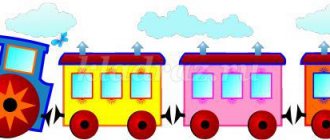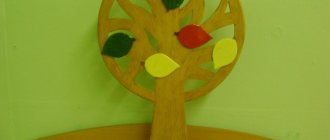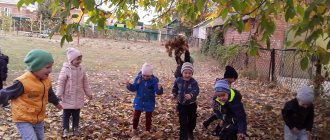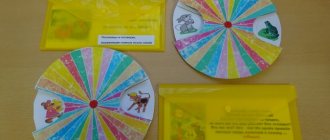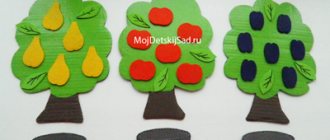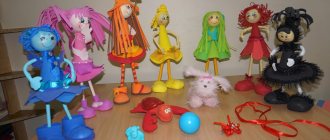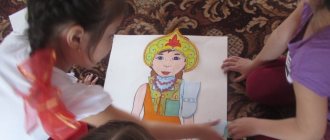Didactic game “What grows in the garden, in the vegetable garden?”
Didactic game “What grows in the garden and vegetable garden”
This manual not only increases the level of the child’s cognitive sphere, but also enriches the vocabulary, allows you to practice grammatical categories, develop coherent speech, allows you to develop the sensorimotor sphere, verbal-logical thinking, improve memory, tactile perception, attention, perception, and develop the creative abilities of children.
Relevance of the manual “What grows in the garden?”
- has developmental, educational and educational significance.
Educational-
Consolidates knowledge about fruits and vegetables, develops cognitive interest in the world around us, helps introduce new concepts - gardening and vegetable gardening, and also develops children's attention, memory and vocabulary.
Developmental-
Develop word formation skills, practice selecting adjectives for nouns on the topic; develop sensory abilities, memory, attention, thinking, fine motor skills of the fingers.
Educational-
to cultivate grateful feelings for nature and people who, thanks to their work, receive a harvest.
Progress of the game:
“What grows in the garden?”
- a traditional game for developing thinking and speech. Children are encouraged to recognize vegetables and fruits and associate them with where they grow.
This manual can be supplemented with the following games:
The game “Wonderful Box” trains fine motor skills, develops imagination and memory
Children take turns taking fruit out of the box and trying to describe its appearance, color, shape).
Game "Pick the sign." Selection of adjectives for nouns.
Tomato (what kind?) - large, round, red, juicy, etc.
Apple (what kind?) - green, round, hard, large, etc.
Game "Fourth wheel". Develops logical thinking, memory, attention, development of tactile sensations.
A fruit representative is placed in a row with vegetables. The child is asked to find the “extra” and justify his choice. Game “One - Many”. Formation of the plural form of nouns. Tomato - Tomatoes, Carrot - carrots, Lemon - lemons, etc.
Game "Greedy". – training in the correct use of the words “my”, “mine”, “mine”, “mine”, and the agreement of words by gender. Mine is a carrot, mine is a tomato, mine is an onion, mine is an apple,
Game "What has changed?" - develops memory and attention. Arrange vegetables and fruits. Ask the children to look at them carefully and remember. Then the children close their eyes. Remove an object or swap objects.
Game "Shop". what did you buy? (Apple) Which apple? (Red, round, hard,) what did you buy? (Lemon) Which lemon? (Yellow, oval, hard, sour), etc.
On the topic: methodological developments, presentations and notes
The main functions of a didactic game. A didactic game is a multifaceted, complex pedagogical phenomenon: it is both a game method of teaching preschool children and advanced.
The purpose and objectives of the musical game, Important aspects, Groups, forms of games.
An article for parents on musical education of preschool children.
Goal: to consolidate children’s knowledge about vegetables, clarify their name, color, shape, teach them to distinguish by appearance; expand the understanding of growing vegetable crops; develop observation and lu.
Expand your understanding of growing vegetables.
Expand your understanding of growing vegetables.
Source
Game-competition “Gifts of Autumn” on the topic: “Vegetables and fruits”
Gomzyakova Irina Nikolaevna Bogatyreva Elena Veniaminovna teachers MBDOU "Kindergarten of a combined type "Teremok" Borisovka village, Belgorod region
The material was sent for publication in the All-Russian printed collection of practice-oriented materials “Preschool and primary education - modern methods and technologies of teaching and upbringing” - SEPTEMBER 2021.
COMPETITION GAME “GIFTS OF AUTUMN” ON THE TOPIC: “VEGETABLES AND FRUITS”
Goal : Generalization and systematization of children’s knowledge about vegetables and fruits.
Advertising message
General education : to develop children’s knowledge about fruits and vegetables, to consolidate the general concepts of “vegetables” and “fruits”;
Developmental : develop attention, imagination, creative thinking, creativity, activate the child’s vocabulary, introduce a new word “TASTE”, develop the ability to solve riddles, select the right word, answer questions;
Educational : cultivate the ability to listen and respect the opinions of your comrades, contribute to the formation of a children's team.
Preliminary work:
- Learning the poem “Gifts of Autumn.”
- Guessing riddles.
- Making crafts from natural materials.
Materials for the lesson:
cut-out pictures for each table on the topic: vegetables, fruits; 2 scarves; diplomas; cups with pieces of fruits and vegetables; aprons, pots and ladles; colour pencils; a bag of vegetables and fruits; 2 cars and baskets; bumps.
Event plan:
- Introductory speech by the presenter (poem, distribution into teams, introduction to the rules of the game...)
- Competition stages:
- School for the Curious
- Vegetables and fruits
- Harvest the harvest
- Tops and roots
- Fun coloring book
- Magic bag
- Transport the harvest
- Cooks
- Taster
- Summing up the results of the game, rewarding.
Progress of the event:
- - Dear Guys! Now I’ll tell you a riddle, and you try to guess it:
“I came without paints and without a brush. And repainted all the leaves.” – What do you think this riddle is about? (about autumn)
- That's right, guys. Today we all gathered here not by chance, but to talk about this interesting time of year - about autumn.
– What is autumn like? Describe it (beautiful, sad, rainy, cold...). – And she’s also generous! After all, she does not come to us empty-handed... - What do we collect in the fall? (harvest). - What is the harvest? (vegetables, fruits, mushrooms, nuts)
- Guys, our girls have prepared a poem for you called “Gifts of Autumn.” Listen to him.
1 child: Hello, Autumn! How are you? What did you bring as a gift? – I brought you vegetables, just a treat. Rich in vitamins My treat for you!
2nd child: If you go into the garden, you will find vegetables there. There are potatoes and tomatoes, pepper, cucumber, salad. If you find yourself in the forest, you will find mushrooms and berries!
3rd child: Take the baskets, collect my gifts! If you go to the garden - wow! I brought you fruits - Pears, apples and melons, I don’t know their taste more wonderful.
- Well done, girls! Guys, what is this poem about? (about fruits and vegetables) -Where do fruits grow? (in the garden) -Where do vegetables grow? (in the garden) - I see that you know a lot about autumn, about fruits and vegetables.
Guys! I propose today to arrange a game-competition and find out who knows more about vegetables and fruits. To do this we need to split into 2 teams.
(Children take turns taking out dummies of vegetables or fruits from a wonderful bag).
– We will now guess what you name your teams:
– Shine on the satin skin. Stop! There is a traffic light in the garden! It shines bright red Juicy ripe... (tomato).
The first team will be called "Tomato".
– We have teams, but who will evaluate us? Who will decide the winning team? (Jury!)
– We present to you our strict jury.
– Now let’s remember the rules of the game:
- Questions are asked to the teams in turn.
- Don't interrupt each other.
- Don't give any hints.
- For each correct answer, the Tomato team receives a vegetable, and the Orange team receives a fruit.
At the end of the game, the jury will count your fruits and vegetables. The team with the most vegetables or fruits will win. Is everyone clear? (Yes!)
– Are the teams ready to play? (Yes!) – Is the jury ready to evaluate us? (Yes!) Let's start playing!
- – The first stage of the game is called “School for the Curious.” I will ask one riddle to each team in turn. Only the team I contact responds. The rest are silent. If a team does not give the correct answer, then the right to answer passes to the next team...:
- Girlfriends live in a green hut. Like beads are round, emerald and small. (peas)
- Yellow, juicy honey fruit grows on a garden tree. (pear)
- Yellow Antoshka Spins on his leg. Where the sun stands, That's where he looks. (sunflower)
4.It is green, round, smooth. And inside it is red and sweet. (watermelon)
- Although it tastes bitter, But inside it is white and strong. And on a grater it is given to those who are sick. (radish)
- Just like a fist. Red barrel, If you touch it, it’s smooth, but if you bite it, it’s sweet (apple).
- An old grandfather is sitting, dressed in a golden fur coat. Whoever undresses him sheds tears. (onion)
- Believe it or not, we come from America. In the fairy tale we are seniors, in the garden... (tomatoes)
- I looked at the sun, became prettier and rounder. I’m not used to the cold, I’m not cabbage, but... (pumpkin)
- It’s not at all difficult to guess, anyone can guess! The leaf is elastic, emerald green and curls into the head. (cabbage)
- I am growing in the ground in a garden bed, red, long, sweet. (carrot)
- It’s unsightly, a little bumpy, but when it comes to the table, the guys will say cheerfully: “Oh, it’s crumbly, it’s delicious!” (potato)
– The second stage of the game “Vegetables and Fruits”. Each team receives cards, which they must quickly and correctly sort into two groups: vegetables and fruits. Collected - raised your hand so that we can see that you have completed the task. The team that collects it first and correctly will receive a vegetable or fruit. It's clear? (Yes!) Let's get started!
– Third competition “Gather the Harvest” . At the leader's command, you must collect as many cones as possible in one minute and put them in your container. The team that collects the most cones will win. But we collect only with our elbows, like this... It's clear? (Yes!) Let's get started!
Now let’s play the attentive game “Tops and Roots.” We will call the edible root of the vegetable roots, and the edible fruit on the stem - tops. I will name a vegetable and if it has an edible root, then you will sit down. And if the top is edible, then raise your hands up.
Carrots (roots), tomatoes (tops), onions (tops and roots) Potatoes (roots), cucumber (tops), beets (roots), parsley (tops), garlic (roots), peas (tops), pepper (tops) .
– The next stage is “Fun Coloring”. Teams receive 4 pictures. The task is to quickly and correctly color the offered vegetable, fruit, berry and mushroom on command. Is the task clear? (Yes!) Let's start!
Physical education minute.
Now let's do a little work in the garden. We got up and did everything together, in unison.
We dug up potatoes, picked cucumbers from the garden, (squats) pulled out all the carrots, (bent over) deftly cut the cabbage. And they brought you a gift in a basket from the earth. Let's continue our game.
– And for this competition ( “Magic Bag” ), volunteers from each team come to me, one from each team.
- Now I blindfold them. Assignment - I approach everyone in turn, they take out one item from my bag, feel it and name it. For each correct answer - a point. It's clear?
- Have you stayed too long, guys? I suggest you move a little, run... We move on to the “Transport the crop” stage. The teams line up behind the line. The task is to put one vegetable or fruit into your car on command, drive the car to the warehouse - basket, unload it and return empty to the team, passing the baton to the next participant, and so on until all the vegetables and fruits are in the warehouse... Is the task clear? (Yes!) Let's get started!
Competition "Cooks"
– And now you will turn into imaginary chefs and cook.
– Team “Orange”, what can you make from apples? (compote, jam, apple pies, salad)
Team “Tomato”, what can you cook from cabbage? (cabbage soup, stewed cabbage, cabbage salad, sauerkraut, cabbage pies, cabbage rolls, schnitzel, dumplings).
– This competition involves one cook at a time. On command, the cooks put on an apron, move the pan inside them, select the products they need, put them in the pan and lift the ladle up, showing us that the task has been completed. And they tell you what they have prepared. It's clear?
– This competition is called “Taster”. Who knows what this word means? Who do we call a taster?
– A taster is a person who can easily identify any object or substance by smell. For example: at a factory that produces perfume, a taster tastes - smells a new perfume and gives it a beautiful name based on its smell.
– Let’s all say the word taster together and remember what it means...
– For this competition, volunteers from each team come to me, one from each team...
- Now I blindfold them. Assignment - I approach each person in turn and offer to identify the product that is on the plate by smell. A token is given for the correct answer. It's clear? (Yes!) Let's get started!
- Our game has come to an end. And now the jury will sum up the results, count your fruits and vegetables and announce the winners...
- While the jury is counting, I suggest you play: if I name a vegetable. Then you stomp your feet, and if it’s fruit, you clap your hands. Let's get ready. Let's start!
– The floor is given to our jury.
Bibliography:
- Poems about autumn – https://www.stihomaniya.ru/2017/07/stixi-pro-dary-oseni.html
- T.A. Shorygina “Vegetables. What are they?”, Moscow, “Gnome and D”, 2007, p.83-84
- “Wonderful Box” (Russian folk songs, fairy tales, games, riddles), Moscow, “Children’s Literature”, 1988.
You can see the table of authors and learn more about the collections HERE
Preview:
Didactic game "Vegetable garden"
Early age group
Developed by: teacher Mentemirova Olesya Veniaminovna
Goal: Formation of ideas about vegetables (carrots, turnips, beets, cabbage, radishes), develop sensory sensations, the ability to hear the teacher, answer questions.
Progress of the game:
Educator: Guys, today we will plant vegetables in our garden bed. In order for our vegetables to grow well, we must first dig up the soil. What do you use to drip the soil with?
Children: With a shovel (Vova, Savely I’m dripping earth).
Educator: Then we will gently level the ground. How will we compare it? Children: Using rakes (Nikita, Daniel level the ground).
Educator: Guys, our garden bed is ready to plant vegetables. I have a basket of vegetables. (The teacher shows the vegetable, the children name it and then plant it in the garden). What is the name of this vegetable?
Children: Carrot (Dasha sits her down).
Educator: What is this?
Children: Onion (Julia sits him down).
Educator: What do I have in my hands?
Children: Turnip (Yaraslava sits her down). And so on, all the vegetables from the basket.
Educator: Guys, we planted the entire garden bed with vegetables. In order for our vegetables to grow quickly, we need to water them. Guys, what are we going to water the garden bed with?
Children: Water from a watering can (Dasha, Alena water the garden bed).
Guys, let's see how our onions that we planted have grown.
The teacher shows the children an onion, what has changed in it? (Feathers appeared). What color are the feathers?
Children: Green
Educator: Guys, do you want to try onions?
Children: Yes.
Educator: Plucks off a little onion and treats the children. What does onion taste like? Children: Bitter, tasteless.
Lesson summary: What did we do with you today? What vegetables did we plant? Well done! Let's put the vegetables in the sun so that they are light and warm.
Didactic game for repetition of the Tatar language “Bar matur bakcha. Beautiful vegetable garden"
Anna Baretskaya
Didactic game for repetition of the Tatar language “Bar matur bakcha. Beautiful vegetable garden"
Municipal autonomous preschool educational institution
"Kindergarten No. 97 combined type"
Moskovsky district of Kazan
Author: teacher of MADOU No. 97
Baretskaya Anna Sergeevna
Goal: To systematize children’s knowledge on the topics “Minem eat” (“My home”, “Yashelchlr m imeshlr” (“Vegetables and fruits”)
.
Educational: to intensify the monologue and dialogic speech of children in two state languages - Russian and Tatar ;
Developmental: develop the ability to master and transform the surrounding space, children's interest in play and speech activities; development of fine motor skills.
Educational: to cultivate interest in learning the Tatar language , the desire to know it.
This manual can be used by the teacher to reinforce words on these topics, and children can also play independently . These games will not bore your child and will make learning interesting and educational.
Material: carpet, construction house, cards with a picture of a family; a set of fruits and vegetables cut out of hard felt. Using tape (Velcro, buttons, glued and sewn on the back side), fruits are attached to the tree, and vegetables to the bed; tree and bed, basket.
Didactic game "Vegetable garden"
Yana Romanchenko
Didactic game "Vegetable garden"
Games with food have always been interesting to children as such. Role-playing games in the “shop”, “ vegetable garden” , “kitchen” are simply irreplaceable for both girls and boys.
Integration of educational areas: “Cognition”
,
"Communication"
,
"Health"
.
The manual consists of six knitted dummies of vegetables (carrots, beets, cabbage)
Goal: to expand and clarify children's knowledge about vegetables.
Task:1) Consolidate knowledge about vegetables. 2) To develop the ability to distinguish vegetables by shape and color. 3) To develop children’s interest in the plant world, to develop cognitive activity and communication skills during joint games.
It’s very interesting to play , firstly, pleasant materials that perfectly stimulate the child’s tactile sensations and secondly, during the game the child generalizes and refines his knowledge about vegetables, where they grow, and their benefits for humans.
The kids can be allowed to play at their own discretion , i.e., whatever they want, they “sit in.” You can also set tasks to develop spatial thinking, for example: “Plant the carrots in the upper right corner and the cabbage in the lower right.” Thanks to the game, you can develop interactive speech in children, for example: “What color are carrots? What about beets?
Progress of the lesson:
Greetings
Hello guys, it's great that you all came today!
Our smart heads will think a lot, cleverly. The ears will listen, the mouth will speak clearly. Hands will clap, Feet will stomp. Our backs straighten, we smile at each other
Surprise moment “Wonderful bag”
Here is my bag. Not simple, but wonderful. Put your hand into it and take out something.
Game "Feed the Bunnies"
Take your vegetables, put them on a plate and feed the bunnies.
Didactic game “What did the bunny eat?”
Here the bunny has cabbage, cucumber and carrots. (The carrot is hiding). What did the bunny eat? The bunny ate a carrot. What's left? All that's left is cabbage and cucumber. What color is cabbage? Green. What color is the cucumber? Green.
Button game “Vegetables in a jar”
Arrange the buttons into circles of the appropriate color and size.
Drawing "Salad"
Look, this picture shows everything you need for a vegetable salad - a salad of vegetables: tomato, cucumber, pepper, onion, salt, oil. And at the bottom of the sheet there is a salad plate - a salad bowl. Take a pencil in your hands and draw lines from each product to the salad bowl.
Didactic game “Plant a vegetable garden”
There are many beds in the garden. There are carrots and lettuce. There are cucumbers and peas here. Are potatoes bad? Our green garden will feed us all year round.
Roll the salt dough into a thick sausage - this will be the bed. Stick carrots into the dough - we will have a bed of carrots.
Drawing “Grow up, carrot”
On a prepared background, children draw horizontal stripes on carrots with a brown pencil.
Exercise “The carrot has grown”
(Done together with parents).
First, they planted a small seed in the ground. (Children squat down)
The sun warmed the cabbage, the rain poured down and the carrots began to grow. (Children slowly get to their feet)
The carrots have grown green leaves. (Raise your hands up)
It's time to pick the carrots. (Parents hug their children and pick them up - they pick carrots from the garden)
Finger game "Vegetables"
The girl Arinochka has vegetables in her basket. (Fold your palms into a “basket”)
Here is a pot-bellied zucchini I placed on a barrel, Pepper and carrots I placed deftly. Tomato and cucumber. (Bend your fingers, starting with the thumb)
Well done Arina. (Show thumb)
Didactic exercise “One-many”
The teacher puts a picture of a vegetable on the magnetic board, and distributes the remaining pictures to the children one at a time.
I have one vegetable. And how much do you have? Anya has one carrot. Denis has one cucumber. Place your vegetables next to mine on the board. How many vegetables are there? A lot of.
Vocabulary work “One-many”
The teacher picks up a vegetable and names it in the singular, then hands it to the child and asks him to name the plural. One carrot, but how can you tell if there are many of them? Lots of... carrots.
One cucumber - many... cucumbers. One tomato - many... tomatoes. One pepper - many... peppers. One potato is a lot of... potatoes. One cabbage is a lot of... cabbage.
Application “Canning vegetables”
Place a large and a small cucumber, a large and a small tomato on top of the jar image. Arrange the vegetables so that they all fit into the jar. Now stick the vegetables onto the jar.
Dynamic pause “Gardeners”
We took the shovels (movements depicting the toe of a shovel on the shoulder)
The beds were dug up. One-two, one-two - That's how they dug it up
They took the rake in hand and combed the beds. One-two, one-two - That's how they combed it. We planted seeds in rows in the ground. One-two, one-two - This is how we planted (movements in accordance with the text)
We watered the beds with cool water. One-two, one-two - This is how they watered (depict watering the beds with a watering can)
The harvest was rich and they gathered together. One-two, one-two - This is how they assembled (tilts)
We started the dances and songs ourselves. One-two, one-two - That’s how they started it. (claps hands)
Exercise "Cooks"
And now you will be cooks, take knives and cut the fruit into pieces. Using plastic knives, children “cut” vegetables into halves (secured with Velcro). — How many pieces did you cut your vegetable into? Let's count: one, two. You cut it into two halves.
Finger painting “Methodius the goat’s vegetable garden”
Show the goat Methodius in the picture. Name what vegetables grow in his garden? Cabbage, carrots, tomato. Now we will color these vegetables. What color should we color the cabbage? Green. What color should we paint the tomato? In red. What color should we paint the carrots? Orange color.
Exercise “Move the peas”
The bunny is hungry again. Let's feed him peas. Spoon the peas from the pan and transfer them to a plate.
Modeling "Pea Pod"
Children make a sausage out of green plasticine and press peas into it.
Finger gymnastics “Salting cabbage”
We chop and chop cabbage. Movements with straight palms We three, three carrots, rub our palms together We salt the cabbage, salt it. Place your fingers into a pinch. We press and press cabbage. Clench and unclench your fists.
Demonstration of the tabletop theater "Methodius the Goat"
Who's wandering around in the garden? - It’s me, the goat Methodius. - For what kind of business? — I help the guards. I protect the cabbage, I protect every leaf... - Why suddenly cabbage, and not radishes and not onions? How can this be, tell me, Methodius?! You forgot about them, it turns out! - I haven’t forgotten anything, But I don’t have enough strength for everything. I don’t know how to preserve onions, but radishes make me lose weight. And cabbage is good, And it needs guards, Because the most delicious, Very tasty - Cabbage leaf!
Vocabulary work “Big and small”
Cucumber is a cucumber. Potato - potato. Cabbage is cabbage. Tomato is a tomato. Onion - onion. Garlic is garlic. Carrot is a carrot. Beetroot - beetroot.
Musical and rhythmic exercise “Harvest”
To the song of the same name, children beat out the rhythm on a metallophone.
Didactic game "Vegetable garden"
Early age group
Developed by: teacher Mentemirova Olesya Veniaminovna
Goal: Formation of ideas about vegetables (carrots, turnips, beets, cabbage, radishes), develop sensory sensations, the ability to hear the teacher, answer questions.
Progress of the game:
Educator: Guys, today we will plant vegetables in our garden bed. In order for our vegetables to grow well, we must first dig up the soil. What do you use to drip the soil with?
My kindergarten
Author: Lyamina Natalya Yurievna , teacher, Municipal budget preschool educational institution of compensatory type N76 “Veterok”, Republic of Tatarstan, Naberezhnye Chelny.
Children line up around the perimeter of the playground.
Host: Guys! Today is an unusual day, hot, summer. We celebrate gardener's day. Since ancient times, all people have worked on the land - planting seeds, digging the ground, watering plants. And for all their labors, Mother Earth gave them a harvest (vegetables, fruits, berries). Let's celebrate the holiday with a cheerful song.
Song "Merry Garden"
Summer enters. Summer: Hello, boys, girls and boys! So the sun woke up, stretched, smiled, invites all the children to go for a walk, and play on the grass!
Host: Hello, summer! Hello summer! Everything is warmed by the bright sun! Let's take a look into the garden, guys. Oh, nothing grows there! Let's plant a garden together.
Game “Planting a Vegetable Garden”
We took shovels and imitated the movements of the beds. They took the rake in hand and leveled the ground. They took watering cans in their hands and watered the beds. The garden has grown and grown!
Host: Guys, what grows in the garden? (vegetables) Correct. What is needed for vegetables to grow? Let's call the rain for help, guys.
Call: Rain, rain, harder, you are our vegetable garden!
Rain comes in. Rain: Hello guys, I’ll help you, I’ll wake up your beds. Let many plants grow in your garden. Let's play a game with you.
Game “Rain, have fun!”
Rain, rain, have fun! Hit your palm with your finger. Drip, drip, don't be sorry! Just don’t kill us by threatening us with your index finger. Don't knock on the window in vain! It’s better to splash it in the garden - “Inviting” hand movements. Let the carrots grow there. Smoothly extend your arms to the sides.
Presenter: Rain, the guys and I know a song about you, listen.
Song “Rain” (in Tatar)
Rain: Well done, guys, what a beautiful, melodious song. The cheerful, mischievous rain came to the garden with me: I hold the rain cloud by the hand.
Song "Tuchka"
Summer: Guys, what else is needed for the vegetables in the garden to grow large, tasty and rosy? (Sun). I suggest you sing a song about the sun.
Song “About the Sun” (in Tatar).
Summer: The rain watered the earth, the sun warmed up. And there are a lot of ripened vegetables in the beds. Guys, what is growing in the garden?
Guess the riddles:
- The red maiden sits in prison, and her braid is on the street. (carrot)
- As I put on a hundred shirts, it crunched in my teeth. (cabbage)
- The grandfather is sitting, dressed in a fur coat, and whoever undresses him sheds tears. (onion)
- In the middle of the courtyard is the Golden Head. (sunflower)
- Our piglets grew up in the garden bed sideways to the sun, with crocheted tails. These little pigs are playing hide and seek with us. (cucumbers)
- Little, bitter brother of Luka. (garlic)
Rain: You guys are bored. Let's have fun and play.
Game “The Bunny Had a Garden”
The bunny had a vegetable garden and spread his arms to the sides. There are exactly two beds. Extend your arms straight forward. There he played snowballs in the winter, imitating “making snowballs”, and in the summer - hide and seek. They squat, covering their eyes with their palms. And in the spring they go to the garden on the spot. The bunny walks happily. But first, everything will be dug up. They imitate digging. And then everything is leveled, they stomp their feet. He sows the seeds deftly, presses his left hand to his chest, and goes to plant carrots. With the right hand they “scatter seeds” Hole – seed, hole – seed, Bend forward. And you look, in the garden again Slowly they raise their hands up, Peas and carrots will grow. Palms parallel to the floor. And when autumn approaches, they spread their arms to the sides. He will reap his harvest. Press your palms to your chest.
Round dance "Garden round dance"
In the garden, in the vegetable garden We walked merrily, In the garden, in the vegetable garden We dug up beds. The seeds were planted in the garden bed, they were lowered into the hole, and then the garden bed was watered with warm water. You grow up quickly, carrot! We will weed the garden bed, the warm rain will fall on you, on the field.
Host: Guys, look how many birds fly in the garden. In order for our vegetables in the beds to grow large, strong, tasty and juicy, so that they are healthy and contain a lot of vitamins, birds should not peck them. Who will scare away the birds? (garden scarecrow).
A garden scarecrow is dressed up in front of the children: the presenter and the characters put a shirt, trousers, and tie on a stick, and a wig and hat are put on the head.
Presenter: This is how beautiful the owner of our garden turned out, he will protect our garden from birds. Let’s go with you to the garden and put up a garden scarecrow.
The presenter and the children install the garden scarecrow in the designated place. (to the garden bed)
At the end of the holiday, children are given treats (fruits).
Fun music is playing, children are having fun with the characters.
